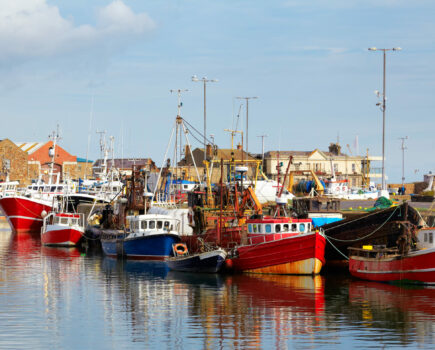A shoal of brightly coloured knitted herring and a new exhibition featuring historic fishermen’s sweaters or ganseys are now on display at the Scottish Fisheries Museum at Anstruther in Fife.
The exhibitions celebrate the textile heritage of Scotland’s fishing communities and the tightly knitted, seamless, water-resistant sweaters that were the distinctive workwear of fishermen between the early 19th and the mid-20th centuries.
The displays form part of the museum’s award- winning Knitting the Herring – Scotland’s National Gansey Project, which began during lockdown in July 2020.
To help support and connect people during lockdown, knitters of all ages were invited to collaborate on the creation of a knitted shoal of herring.
Jen Gordon, assistant curator at the Scottish Fisheries Museum, said: “With Knitting the Herring we wanted to share our wonderful collection of ganseys and raise awareness of the craft heritage, culture and traditions of our Scottish fishing communities. We’re thrilled that the shoal project, added in response to the growing isolation felt by so many during lockdown, has been a terrific success.”
The museum collaborated with leading designers, contemporary artists and knitters from across the world to create gansey-inspired patterns, from a simple square to a gansey-patterned fish.
“As the country entered the dark and cold months of winter with weeks of uncertainty ahead of us, we were buoyed up to receive little parcels of woolly goodness from Scotland, the UK and Europe as everyone embraced the challenge of designing and knitting their herring.
“Our contributors were sometimes shy about their work, but we hope they have now seen how all these small and seemingly isolated crafty endeavours have come together to create something beautiful. At last, our shoal of herring can swim alongside the ganseys that inspired it,” said Jen Gordon.
Ganseys were once an integral part of fisherfolk’s everyday life, and were worn by members of the fishing community from a very young age. Most men owned up to six ganseys at one time, with one kept for Sunday best and special occasions.
Created by a family member, they were usually dark blue but sometimes grey, cream or even red and reflected the often unsung creativity and craft of the women of fishing communities.
Short at the waist and sleeves to allow freedom of movement for physical tasks onboard and layered with distinctive patterning across the chest for insulation, ganseys were rarely washed so that grease could gradually build up to increase warmth.
Patterns included items from a fisherman’s daily life such as a net, herringbone or anchor, or more complex motifs such as the tree of life and a zigzagging design reflecting the ups and downs of married life.
The knitting and wearing of traditional ganseys, which were also worn by lifeboat and ferry crews, and merchant seamen, began to die out after the Second World War.
The exhibition runs until 27 February.
For further information visit the Scottish Fisheries Museum here or Scotland’s National Gansey Project here.
This story was taken from the latest issue of Fishing News. For more up-to-date and in-depth reports on the UK and Irish commercial fishing sector, subscribe to Fishing News here or buy the latest single issue for just £3.30 here.








